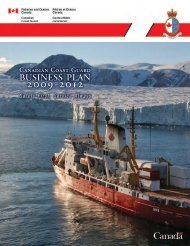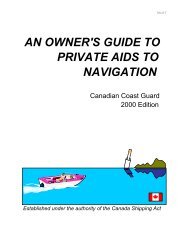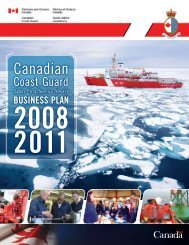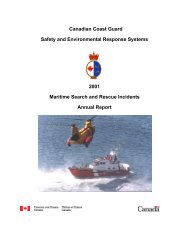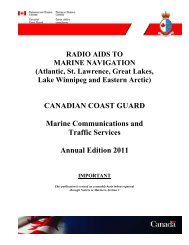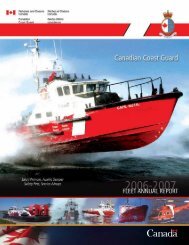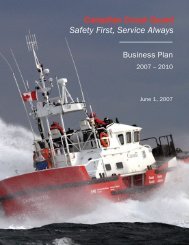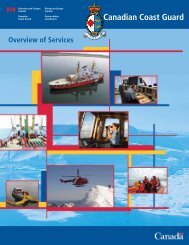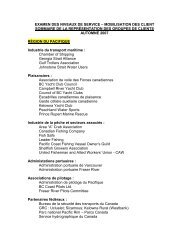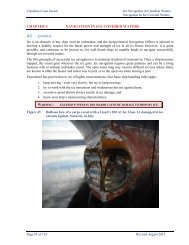PART 4 - Canadian Coast Guard
PART 4 - Canadian Coast Guard
PART 4 - Canadian Coast Guard
Create successful ePaper yourself
Turn your PDF publications into a flip-book with our unique Google optimized e-Paper software.
The radiotelephone distress frequencies are:<br />
i) 2182 kHz on medium frequency (MF) band; and<br />
ii) 156.8 MHz (channel 16) on very high frequency band (VHF); and<br />
iii) any other available frequency on which attention might be attracted if transmissions on 2182 kHz and 156.8 MHz are<br />
not possible or successful.<br />
The digital selective calling (DSC) frequencies are:<br />
i) Channel 70 in the VHF band;<br />
ii) 4207.5 kHz;<br />
iii) 6312.0 kHz;<br />
iv) 8414.5 kHz;<br />
v) 12577 kHz; and<br />
vi) 16804.5 kHz in the High Frequency (HF) bands.<br />
When another craft or person is in distress;<br />
i) all transmissions capable of interfering with the distress traffic must be stopped;<br />
ii) attention must be concentrated on the distress communications and all information possible intercepted; and<br />
iii) a station in the vicinity of the distressed craft must acknowledge receipt of the distress message if received, giving its<br />
own position in relation to that of the craft in distress and stating the action being taken.<br />
Distress communications consist of the:<br />
• Distress Signal;<br />
• Distress Call;<br />
• Distress Message; and<br />
• Distress Traffic.<br />
Transmission of a Distress Signal and/or a Distress Call announces that the ship, aircraft, other vehicle, or person that is<br />
making the transmission is:<br />
i) threatened by serious and imminent danger and requires immediate assistance; or<br />
ii) aware of another ship, aircraft, other vehicle, or person threatened by serious and imminent danger and requires<br />
immediate assistance; and<br />
iii) distress communications should be repeated by the craft in distress until an answer is heard.<br />
The Alarm Signal<br />
The radiotelephone Alarm Signal consists of the continuous alternate transmission of two audio tones of different pitch for<br />
a period of at least thirty seconds but not to exceed one minute. The sound of this tone is similar to that used by some<br />
ambulances.<br />
The Alarm Signal is used by <strong>Canadian</strong> MCTS Centres to alert ships:<br />
i) that a mayday relay broadcast is about to follow; or<br />
ii) that a Tsunami warning, which should be preceded by the Urgency Signal (PAN PAN) is about to follow; or<br />
iii) that the transmission of an urgent cyclone warning, which should be preceded by the Safety Signal (SÉCURITÉ), is<br />
about to follow.<br />
The Alarm Signal transmitted by the coast radio station will normally be sent for a period not exceeding thirty (30) seconds<br />
and will be followed by a ten (10) second continuous tone.<br />
The Distress Signal consists of the word “MAYDAY”.<br />
The Distress Call consists of:<br />
i) the word “MAYDAY” (spoken three times)<br />
ii) the words “This is” followed by<br />
iii) the name of the ship in distress (spoken three times), and<br />
iv) the ship's MMSI number (if a DSC distress alert has been sent).<br />
4-5



